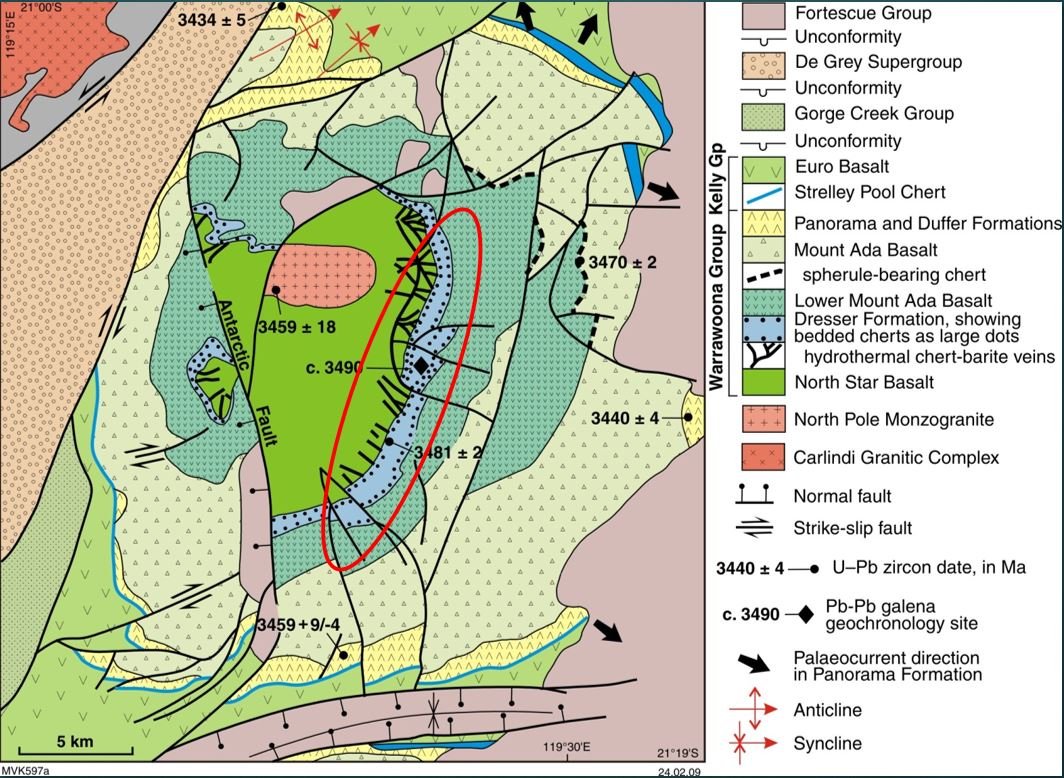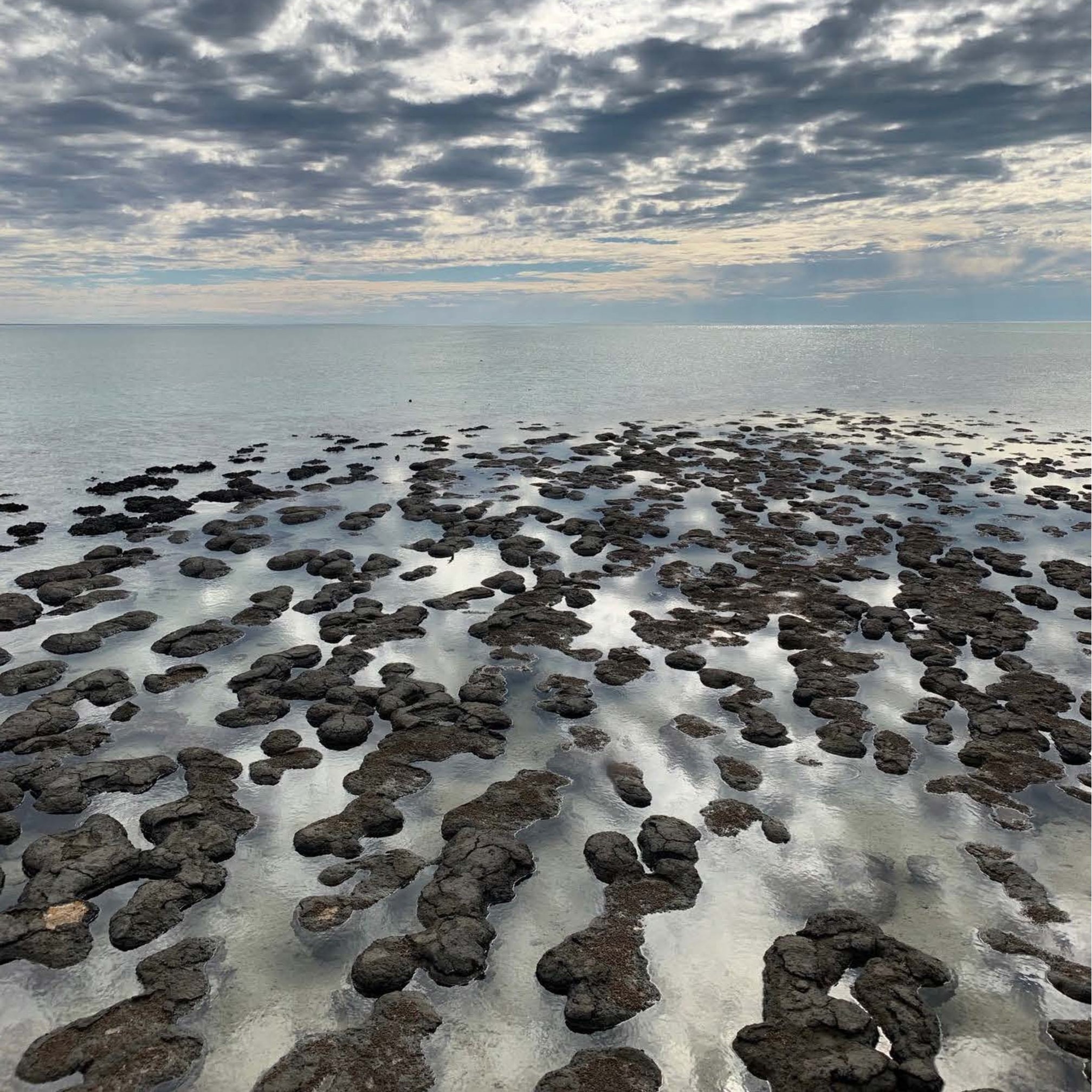Martin Van Kranendonk on the Earliest Life on Earth
Listen to the podcast here, or wherever you get your podcasts.
Scroll down for podcast illustrations.
To find evidence for very ancient life, we need to look at rocks that have been largely undisturbed over billions of years of Earth history. Such rocks have been found in the Pilbara region of northwest Australia. As Martin Van Kranendonk explains in the podcast, the 3.48-billion-year-old (Ga) rocks of the Dresser Formation there contain exceptionally well-preserved features that show unmistakable physical and chemical signatures of life. While older 3.7 Ga rocks in west Greenland may also prove to have harbored life, the Dresser Formation rocks represent the oldest widely accepted evidence for life on Earth.
Martin Van Kranendonk is a Professor in the School of Biological, Earth, & Environmental Sciences at the University of New South Wales in Sydney.
Podcast Illustrations
Images courtesy of Martin Van Kranendonk unless otherwise noted.
Map of the Pilbara region of Western Australia.
DevelopmentWA
Pilbara landscape.
Geological map showing the geological context of the 3.5-billion-year-old Dresser Formation (sky blue) in the Pilbara Craton.
Dresser Formation on the Surface
Above: highly weathered outcrop of wrinkly laminated stromatolites (below knife) and domed stromatolites (background). Left: tops of cone-like stromatolites. Below: well-preserved ripples suggest a shallow water environment.
Yellow and green lines indicate sediment onlapping onto the side of a stromatolite.
Dresser formation outcrop annotated to distinguish biogenic structures from those produced by purely inorganic processes. The white arrow indicates a 3.5-billion-year-old stromatolit with wrinkly lamination.
Drilling into the Dresser Formation in 2019 when the exceptionally well-preserved 3.48 Ga stromatolites were found about 90 meters below the surface.
In the podcast, Martin Van Kranendonk describes the team’s excitement upon first seeing this sample of the drill core with four small domal stromatolites with wrinkly laminations in yellow, growing up from a flat-lying bed below. The core is about 7 cm across, and the stromatolites are about 1 cm high.
In this section, the distribution of iron (Fe) is mapped. The yellow lines delineate planar bedding, and the red arrows and lines show stromatolite columns surrounded by asymmetrical ripples, which suggests a water current was flowing from left to right.
Organic Matter in the Dresser Formation Stromatolites
Baumgartner, R.J., et al. (2019) Geology 47, 1039
Photomicrograph of stromatolites in the Dresser Formation in the Pilbara, Western Australia. The stromatolite textures range from upward-broadening and/or upward-branching finger-like structures (white arrows), to wavy and wrinkly laminae that are sometimes arranged in a columnar fashion. The inset shows a schematic drawing for stromatolite lamination.
Much of the organic matter found in the Dresser Formation stromatolites occurs in tiny pores within pyrite. Top right: scanning electron microscope image of the porous pyrite. Bottom right: infrared spectrum showing peaks in the D and G bands indicating the presence of carbon.
Pyrite textures in the Dresser Formation stromatolites showing putative growth orientation of vertical, locally upward-branching and/or upward-broadening patterns (black arrows).
Organic matter strands and filaments in pyrite of the Dresser Formation. (A) Electron microscope image of a branched organic matter strand that is embedded in porous pyrite (red arrow). (B, C) Organic matter strands cross pyrite grain boundaries (red arrows in B). (D) Twisted filament bundle (red arrow) containing barite (barium sulfate, Brt).
Transition Metals in the Dresser Formation Stromatolites
Element distribution maps of Dresser Formation Stromatolites. As discussed in the podcast, elements such as nickel, zinc, and arsenic are produced as a by-product of certain microbial metabolisms. Left: color-coded distribution maps of nickel, arsenic, and zinc. The white arrows show the wavy laminae with central enrichment of nickel. Right: closeup distribution map of nickel and zinc. The images are high-resolution, X-Ray fluorescence maps made using the Australian Synchrotron in Melbourne.
Baumgartner, R.J., et al. (2020) Precambrian Research 337 (2020) 105534
Living Stromatolites
Stromatolites are mats of sediment created by microbial communities living on their surface. Images from Shark Bay except the one below from Lake Clifton, just south of Perth.
Courtesy of Bernd Nicolaisen
Courtesy of Richard Murphy
Further Reading
Baumgartner, R.J., et al. (2019) Nano−porous pyrite and organic matter in 3.5-billion-year-old stromatolites record primordial life, Geology 47, 1039.
Baumgartner, R.J., et al. (2020) Accumulation of transition metals and metalloids in sulfidized stromatolites of the 3.48 billion–year–old Dresser Formation, Pilbara Craton, Precambrian Research 337 105534.
Van Kranendonk, M.J., et al. (2008): Geological setting of Earth’s oldest fossils in the c. 3.5 Ga Dresser Formation, Pilbara Craton, Western Australia. Precambrian Research 167, 93-124. DOI 10.1016/j.precamres.2008.07.003.
Van Kranendonk, M.J., et al. (2021): Life analogue sites for Mars from early Earth: Diverse habitats from the Pilbara Craton and Mount Bruce Supergroup, Western Australia. In: R.J. Soare, S.J. Conway, D.Z. Oehler, and J.-P. Williams (eds), Mars Geological Enigmas: From the Late Noachian Epoch to the Present Day, pp. 357-403, Elsevier Inc. USA, 554p.
Van Kranendonk, M.J., et al. (2021): Elements for the Origin of Life on Land: A deep-time perspective from the Pilbara Craton of Western Australia. Astrobiology, 21(1), 39-59. DOI: 10.1089/ast.2019.2107.
Djokic, T.,et al.. (2021): A reconstructed subaerial hot spring field in the ~3.5 billion-year-old Dresser Formation, North Pole Dome, Pilbara Craton, Western Australia. Astrobiology 21(1), 1-38. DOI: 10.1089/ast.2019.2072.
Ruff, S.W., et al. (2020): The case for ancient hot springs in Gusev Crater, Mars. Astrobiology 20, 475-499. DOI: 10.1089/ast.2019.2044.
Van Kranendonk, M.J., et al. (2019): Depositional setting of the fossiliferous, c. 3480 Ma Dresser Formation, Pilbara Craton: A review. In: Van Kranendonk, M.J., Bennett, V., Hoffmann, E. (eds.), Earth’s Oldest Rocks, 2nd Edition. Elsevier, USA; p. 985-1006.
Djokic, T., et al. (2017): Earliest signs of life on land preserved in c. 3.5 Ga hot spring deposits. Nature Communications 8:15263. DOI:10.1038/ncomms15263





















